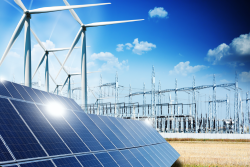Energy Efficiency
Energy is one of the few commonly shared resources among business, industry, and the public. Very little gets done without out consuming some form or type of energy, be it electricity, natural gas, gasoline, diesel fuel, propane, etc. Until recent times, most energy was derived from the consumption of fossil fuels, which are not renewable. However, the field of energy generation and consumption has been rapidly changing since the creation of technology that reduces demand or produces renewable energy.
Printing operations, like any other manufacturer, should be aware of their energy consumption profile and work to reduce, where feasible, their energy consumption. There are many benefits to be gained by reducing energy consumption with a primary focus on financial and environmental impacts. A key measure of environmental impact of energy is a facility’s carbon footprint and reducing it pays many dividends. There are many ways to reduce your carbon footprint, including improving energy efficiencies, use of renewable energy resources, and offsetting emissions. There are also programs available that incentivize efficiency and renewable energy use including low cost financing opportunities and tax deductions.
Benefits of Energy Efficiency
 According to the US EPA, improving energy efficiency is one of the most constructive and cost–effective ways to
address the challenges of high energy prices, energy security and independence, air pollution, and global climate change. The benefits are widespread in that they reach each element of the triple bottom line—People, Planet, Profit.
According to the US EPA, improving energy efficiency is one of the most constructive and cost–effective ways to
address the challenges of high energy prices, energy security and independence, air pollution, and global climate change. The benefits are widespread in that they reach each element of the triple bottom line—People, Planet, Profit.
- Increased efficiency lowers greenhouse gas emissions, other pollutants, and water use.
- Increased efficiency and reducing energy use are typically less expensive than investing in new energy generation. It can create downward pressure on energy source prices.
- Furthermore, efficiency can save your facility money on your utility bill and on operations and maintenance costs!
- Increased efficiency can benefit Utility Systems by lowering baseload and peak demand levels which reduces the need for additional generation and transmission assets.
- Increased efficiency diversifies utility resources which reduces uncertainty associated with fluctuating fuel prices.
How to Achieve Energy Efficiency
There are many simple ways to increase efficiency in your facility. Some options include:
- Use less. Turn off lights, install motion-sensor lighting, keep HVAC system at the manufacturer recommended setting to reduce
 any unnecessary energy use.
any unnecessary energy use. - Replace old devices. Install energy-efficient lightbulbs and lighting systems, appliances, toilets and sinks, HVAC units, or other energy consuming technology. In some instances, there may be a higher up-front cost, but money will be saved in the long term. Use this Life Cycle Costing Calculator from World Class Manufacturing to determine the true cost of different technologies you may be deciding between.
- Check your insulation. A poorly insulated building can cause a facility to use much more energy than necessary.
- When changing roofs, look to newer technologies that can reduce energy consumption. One example is to incorporate lighter colored roofing materials in areas where the weather is consistently warm. The light roof reflects sunlight and does not absorb it as what occurs with darker roofs.
Find more ways to reduce your energy consumption here. Learn more about energy efficiency here.
Renewable Energy Sources & Storage
Before investing in any renewable energy source, it is wise to learn more about what is prevalent and cost effective in your area. See what renewable energies are being produced in your state with this interactive map. As renewable energy sources harness energy from nature, climate and weather, these factors affect the effectiveness of most renewable energies in different areas.
 It is also a good idea to learn more about the technologies available to produce and utilize each renewable energy to find what source will work best for you and your needs. The Department of Energy identifies each renewable energy source,
including solar, wind, water, geothermal, bioenergy, and nuclear. Peruse the site to learn more about each type.
It is also a good idea to learn more about the technologies available to produce and utilize each renewable energy to find what source will work best for you and your needs. The Department of Energy identifies each renewable energy source,
including solar, wind, water, geothermal, bioenergy, and nuclear. Peruse the site to learn more about each type.
Energy storage is also an important emerging approach that is being incorporated. Many renewable energy sources are dependent on time of day, weather patterns, etc. Therefore, the ability to harness and store excess energy for a later time when the sun is not shining, or the wind is not blowing can be the key to energy security and independence.
Carbon Offsets
Carbon offsets are a valid way to reduce your overall carbon footprint by reducing carbon emissions elsewhere to compensate for emissions you are producing. There are two ways your company may be involved with carbon offsets, either voluntarily or by government mandate.
Government Mandated Market Based Policy Currently, 11 states operate in a market based, or Cap and Trade approach to regulating  the amount of carbon dioxide that
is emitted. These programs focus on large emitters such as power plants and set a price on carbon as an incentive for reductions by major emitters. Businesses with emissions lower than the cap set by the government can sell their unused credits to
businesses that are struggling to reduce their emissions to be within regulatory standards.
the amount of carbon dioxide that
is emitted. These programs focus on large emitters such as power plants and set a price on carbon as an incentive for reductions by major emitters. Businesses with emissions lower than the cap set by the government can sell their unused credits to
businesses that are struggling to reduce their emissions to be within regulatory standards.
Voluntary Business also can balance out their carbon footprint by funding projects that reduce greenhouse gases. These projects may include funding carbon sequestration and storage, reforestation, reducing deforestation, preventing greenhouse gas release, generating clean energy, etc. The most common way for a business to purchase offsets is through a company that develops offset projects (such as Carbonfund.org or TerraPass). Businesses may also purchase offsets through directly funding a project (such as technology to capture and utilize methane at a landfill, etc.) or by buying offsets through market exchanges.
Financing Renewable Energy and Efficiencies
The Office of Energy Efficiency & Renewable Energy (EERE) does not want funding issues to stand in the way of progressive energy upgrades. Therefore, they provide funding and information on funding opportunities your business can take advantage of to help achieve energy efficiency goals.

- EERE has many useful resources to take advantage of. Use these links to Apply for EERE funding, and search for available funds, grants, and tax incentives. You may also utilize this EERE tool to calculate Commercial Building tax deductions as well as this Clean Energy Financing Guide.
- Green Lease Library is a comprehensive site for commercial green leasing resources.
- North Carolina Clean Energy Technology Center has created a Database of State Incentives for Renewables & Efficiency (DSIRE) throughout the United States.
- Energy Star, a U.S. Environmental Protection Agency voluntary program that helps businesses and individuals save money and protect our climate through superior energy efficiency, has a
Building Upgrade Manual. It is a comprehensive guide to profitable energy efficiency upgrades. While the entire Manual may be of use,
Chapter 4 discusses Financing.
- Energy Star also has recommendations for energy efficiency products, and how to improve efficiency in your building.

- Energy Star also has recommendations for energy efficiency products, and how to improve efficiency in your building.
- Green Power Partnership is a free, voluntary program, open to businesses of all sizes helping to increase the use of green power among organizations in the United
States. Find the benefits of becoming a partner here.
- EPA has many more Clean Energy Programs on their website. Find one that works for you!
PRINTING United Alliance’s Sustainability Issues and Trends resources provide practical information meant to allow printing operations to manage compliance and stay informed. For more information on Energy or other Sustainability topics, email govtaffairs@sgia.org or call 888-385-3588.